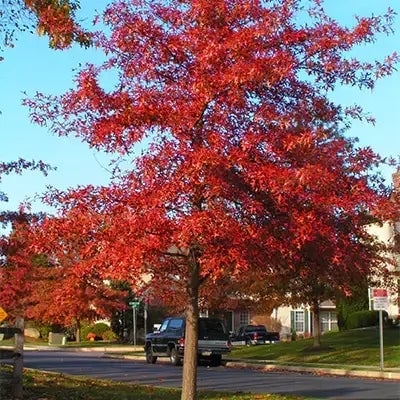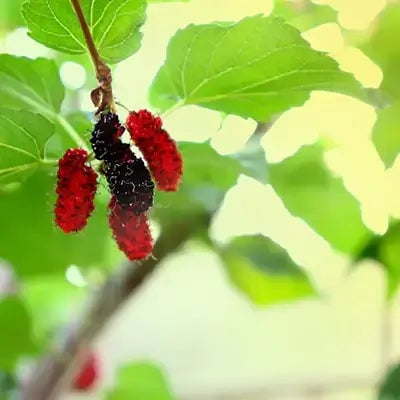Mulberry is one of the most accessible trees you can grow in your garden. Besides bringing ornamental value to your garden, it helps to attract birds and provides reliable fruit produce. Mulberries can grow everywhere and produce plentiful fruits yearly, making them one of the best plants you can get for your garden.
Mulberries make good landscape additions. It is one of the most adaptable plants, and you can plant it anywhere. It tolerates harsh weather conditions like wind, cold, drought, and partial shade. The tree requires little fertilization, which is enough to keep them going. It only needs a little water due to the deep taproots that allow the tree to access groundwater if available. Mature Mulberry trees will not need regular weeding since they grow well amongst different plants. With occasional pruning of the lower limbs, you enable other plants to grow under mulberries, and you have easy access around the tree. Your Mulberry tree can have good companions in the garden, including chives and onions and other fruiting trees like cherry or even flowers such as marigolds. In addition, it will help you preserve your other fruits in your orchard since birds love Mulberry fruits and will eat them, leaving others, like cherries, unscathed.
Bloom time for mulberries is spring, and you will notice yellowish-green flower color in your trees. While blooming occurs in spring, harvesting Mulberries can happen in summer or early fall. In the beginning, the fruits are cream-white. Then it slowly ripens, changing from dark red or almost black color. Once your tree matures, it will be healthy for the next 25 years to bear fruit. In addition, the trees are not demanding. Plenty of sunlight, regular watering, and adding appropriate nutrients to the soil are all you need to ensure they are well established and encourage blooming.
Late spring is a proper time to introduce the Mulberry plant to your garden. There are three most commonly grown varieties of the mulberry tree. Black Mulberry, a native of Asia, has large berries when ripe. Its other name is Morus nigra. White Mulberry, a native of China, has a blackberry-shaped fruit. It is also known as Morus alba. The red Mulberry is from North America and has long leaves and a coarse, hairy underside. It is also known as Morus Rubra. The average size of a mature mulberry is 30-60ft tall and 20-40 ft wide. Mulberry planting trees are accessible from cultivators. You can buy at the low prices offered and enjoy fast shipping. You can even go for a supplier that ships nationwide.
Consider planting mulberry trees when you landscape your space. This versatile tree offers over 200 varieties suited to many climates and locations.
Mulberry trees are fast-growing and provide a spreading canopy of shade in a few short years. That is one reason that they are desirable for many landscapes. They often have leaves of varying shapes, so they are interesting specimens when seen up close. Some of the lobed, serrated leaves are heart-shaped; others are described as looking like mittens.
Those people who want to encourage birds and other wild life will find the mulberries themselves to be an attractive feature. In fact, they may want to harvest some of these mild delicious drupes for their own dining pleasure. They can be eaten as is, or baked into pies and cobblers. Mulberries also can be made into jams and jellies.
Property owners who do not want the birds to leave mulberry stains around their property can still take advantage of these lovely trees by purchasing "fruitless" mulberries. Fruitless mulberries are male white mulberry trees (morus alba variety). There are many mulberry varieties that can suit almost any climate and offer shade and beauty to the area. Another white mulberry of interest is the contorted "Unryu" mulberry. This is also a large tree with twisted or contorted branches.
Characteristics Of The Tree
Attractive characteristics of mulberry trees, besides their fast growth, are their adaptability and long life. They do not require heavy feeding to prosper, and will continue to grow for many years. In Missouri there is a white mulberry tree that is 48 feet tall with a span of 57 feet across. It likely came up in the fence row of a farmstead in the late 1800s. It is just one example of the enduring fruit tree.
Besides the white mulberry, there are other varieties, such as the red mulberry (Morus rubra), which grows to a similar height. It does well on rural properties and in the city as well. Mulberry trees do not seem to be damaged by the pollution in city environments. They are resistant to diseases and pests.
The black mulberry (Morus nigra) is a smaller tree, usually growing to about thirty-five feet. It also produces darker-colored fruit and is more suited to smaller spaces than the white or red varieties. For real garden interest, there is a variety of black mulberry that is fruited, called the weeping mulberry. It has a growth habit that trails downward and grows to no more than twelve feet tall and sixteen wide. There is also a non-fruiting white weeping mulberry. Morus alba pendula may be just the specimen plant your home landscape needs.
Lastly, if you find you must remove a mulberry tree, the wood is attractive for crafting and has a pleasant aroma when burned. Mulberry trees are excellent for your gardening needs.
Creative and Delicious Ways to Enjoy Mulberries
Mulberries exhibit a sweet flavor and delicate texture while displaying vibrant, deep hues. Although they lack the mainstream popularity of strawberries or blueberries, their versatility provides a wealth of culinary options. The berries enhance baked goods and savory sauces by delivering flavor and nutritional benefits. These recipes demonstrate numerous ways to add mulberries to your cooking repertoire so you can enjoy every last flavorful, antioxidant-packed berry.
The easiest way to enjoy mulberries is to eat them fresh, directly from your hand. Mulberries reach their peak flavor when fully ripe and provide an exceptional candy-like sweetness that surpasses other berries. If your mulberries lack enough sweetness for your taste buds, you can sprinkle them with a small amount of sugar or pour a thin layer of honey over them. These methods reveal the berries' natural sweet flavors while maintaining their delicate tart taste.
People who want a speedy, refreshing snack should make mulberry smoothies. Mix mulberries with fruits like bananas, strawberries, or peaches, and include yogurt or milk for a smooth texture. You can enhance the dish's nutritional value by adding spinach or kale because they integrate seamlessly into the sweet berry-based mixture. The final beverage delivers vibrant colors and antioxidant benefits, making it ideal for morning consumption or as an afternoon treat.
Mulberries demonstrate exceptional quality when they become ingredients in baked products. When baked into muffins or sprinkled across scone dough, mulberries develop a delightful melt-in-your-mouth texture due to their sweetness softening under heat. Mulberry pies and crumbles are especially delightful. As the berries decompose, they create a juicy filling that provides a pleasant contrast to flaky pastry and crumb toppings. The taste of mulberries reaches new heights when combined with complementary flavors such as lemon zest, vanilla, or nutmeg.
Making jams or jellies is an excellent method to extend mulberry enjoyment throughout the year. The mixture thickens after simmering berries with sugar and lemon juice. Mix herbs such as rosemary or mint to introduce diverse tastes to your creations. Use your homemade mulberry jam as a topping for toast, or mix it into yogurt to create a sweet snack.
For those who enjoy culinary experiments, try creating mulberry syrup. Cook the berries and sugar mixture on low heat until it thickens and becomes a sweet condiment that enhances pancakes, waffles, and ice cream. Mulberry syrup also finds its way into barbecue sauces and glazes to enhance their smoky and tangy flavors with added depth and richness.
Explore dried mulberries, as they offer valuable culinary possibilities. The dehydration process makes mulberries taste more intense while giving them a desirable chewy consistency. Dried mulberries make a tasty addition to oatmeal or yogurt and enhance trail mix recipes when combined with nuts and other dried fruits. They are also excellent in granola bars or homemade snack bars since they bring natural sweetness and vitamins.
Mulberries can be eaten fresh or dried, enjoyed baked or cooked into jam, and they bring delightful versatility to any dish. Use these ideas to explore new taste combinations and discover fresh methods to introduce a sweet element into your daily foods and treats. Exploring all the different forms and uses of mulberries will lead you to find countless ways to appreciate this underrated berry.
Read more

The Ox-Eye Daisy is a wildflower found throughout the country. Its common name comes from its long eyelashes, which look like an ox's eyes. Ox-eye daisies attract birds partly because they have sev...

Pin Oak Description The pin oak tree, which goes by the Latin name Quercus palustris, is a large and full finely-shaped shade tree that belongs to the red oak family. The tree has a growth rate o...


